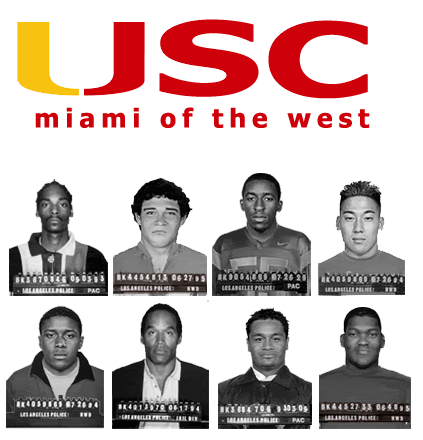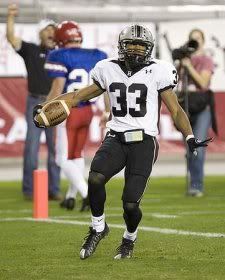 It was a complaint you heard a lot last season, "The play calling is too conservative". It started as a whisper after the game against Rice, it became a loud conversation after the loss to Washington, and it was being shouted from the roof tops after the Bruins lost 4 in a row. It wasn't a pretty situation and Coach Sovboda was eventually fired because of it.
It was a complaint you heard a lot last season, "The play calling is too conservative". It started as a whisper after the game against Rice, it became a loud conversation after the loss to Washington, and it was being shouted from the roof tops after the Bruins lost 4 in a row. It wasn't a pretty situation and Coach Sovboda was eventually fired because of it.It is easy and common for fans to get upset and blame the coaches, and the play calling, when things go wrong. You hear fans from all schools do it and they do it more often as the losses pile up. Now that I have detailed statistics about the football teams in the PAC-10, I wanted to see if I could confirm or deny the belief that our play calling last year was too conservative. I think the answer will be enlightening.
In the Red Zone
In order to narrow down this topic, I decided to focus on red zone play calling. It seemed like the Bruins moved the ball pretty well last year between the 20's, but when they got into the red zone things would stall. We ended up kicking a lot of field goals, which I'm sure made Justin Medlock pretty happy, but it didn't sit well with the fans.
I ran my queries for all 10 teams in the conference. I figured that way I could get a pretty good comparison between UCLA and other schools. In particular, I wanted to see how the Bruins stacked up against the best offenses in the conference (USC, California, and Oregon) and the worst offenses (Stanford and Arizona).
How we define "conservative" is an important piece to this analysis. It is kind of subjective as each fan will have their own opinion of what the team should be doing. I figured I would go with a fairly simple definition. As the field shortens, it becomes more difficult to pass the ball, so I would say the conservative coach would run the ball more in the red zone than pass. I would also say going for it on 4th down is not something a conservative coach would attempt. Using those measurements as my standard, I crunched the numbers.
UCLA ran the ball 82 times in the red zone and passed it only 42 times. When you compare that to USC, it seems pretty conservative. The Trojans actually passed more in the red zone, 75 times to only 60 rushing attempts. At first I thought that was a pretty glaring difference, but if you look at other top offenses in the conference, like California, they had a similar ratio of passes to runs (2 runs for every 1 pass). Oregon falls in the middle between the pass happy Trojans and the run heavy Bruins and Bears. These numbers don't really give us a clear answer either way but it definitely doesn't point to UCLA being very aggressive in the red zone.
To further confirm that point, the Bruins converted 11 field goals (which ranks them first in the conference) when facing 4th down in the red zone. We only went for it once on 4th down. The Trojans, Bears, and Ducks did attempt to covert more 4th downs, but not many more. The Trojans were ultra aggressive with 5 attempts. Again, a clear answer doesn't seem to emerge from these numbers either.
Goal to Go
 Since the red zone numbers were inconclusive, I narrowed the focus down even more, to just look at goal-line situations. I only looked at plays where the team faced 1st and goal-to-go and then analyzed the results. It was here that the numbers were very telling.
Since the red zone numbers were inconclusive, I narrowed the focus down even more, to just look at goal-line situations. I only looked at plays where the team faced 1st and goal-to-go and then analyzed the results. It was here that the numbers were very telling.Again, determining what is considered "conservative" is a bit subjective. Here I decided that following the play calling pattern of run-run-pass would be a pretty conservative one. I looked at each down independently to see what was being executed.
In 1st and goal the Bruins ran the ball 17 times and only passed once. I was startled to see such a disparity in the numbers. No other team ran the ball more on first down. To make matters worse, the Bruins only averaged 1.3 yards per attempt; the only teams to average less yards per running attempt on 1st down were Stanford and Arizona. Despite the lack of results, the coaches continued to run the ball almost exclusively on 1st and goal.
On second down, things weren't that much better. The Bruins ran the ball 9 times and passed 6 times. We actually averaged less than one yard per running attempt on 2nd down, which ranked the Bruins 9th on the list. Sadly, the Bruins average 3.9 yards per passing attempt which put us 2nd. Instead of passing on second down, we were running, and getting nowhere.
Third downs were the exact opposite. We ran 4 times and passed 6 times. We averaged only 1.3 yards per pass attempt, again ranking us 9th on the list. On the four rushing attempts, we averaged 2 yards, which ranked us 2nd behind Oregon. Here we passed to little success when we could have been rushing for more yards.
It looks like the offense followed the run-run-pass pattern pretty consistently. When we followed that pattern, we gained very few yards. When we broke the pattern, we were one of the more successful teams in the conference. Unfortunately, last season we followed that conservative pattern far too often. So it should come as no surprise that the Bruins had the 3rd lowest TD percentage of all PAC-10 teams in goal-to-go situations.
When you compare these numbers to the more successful offenses in the conference, you'll see that they had a much more balanced attack in goal line situations. The Trojans ran a perfectly balanced 16 running plays and 16 passing plays in 1st and goal to go. California and Oregon ran the ball more on 1st down then USC but not with the same disparity as the Bruins.
There aren't a whole lot of plays in goal line situations, so the impact probably wasn't huge to the overall results of the team. However, the Bruins didn't capitalize on some golden opportunities to score touchdowns and the play calling was a big part of that.
You know what you know
Just to be perfectly fair, these numbers are only based on what plays were actually executed. In the modern college football offense, most plays come into the huddle with options to run or passs. The quarterback can also check-out of the called play and pick something new based on the defense he sees. We can never know exactly what was called on each play, but it seems reasonable to believe that the play executed was the same thing that came into the huddle the vast majority of the time.
Also, in the spirit of openness and honesty, this analysis is a bit superficial. It doesn't take into account the defensive formation or the specific game situation for each play. It could be possible, though highly unlikely, that running the ball 95% of the time on 1st and goal was the right decision based on what the defensive presented. Since I don't have that information, I can not be 100% certain.
That being said, I feel pretty confident in the analysis because other teams, like USC, used a markedly different mix of plays in similar situations and they played an almost identical schedule to UCLA. Personnel plays a role, and I'm sure that effected the offense strategy. But blaming the lack of scoring on the players doesn't explain why the Bruins were more successful when they diverted away from the conservative play calling mix.
Dorrell vs Svoboda
 I'm sure the guys over at Bruins Nation and Dump Dorrell will be interested to know that when you perform this same analysis for the games where Dorrell had input (i.e. after the WSU game) and when just Svoboda was in charge (i.e. WSU and earlier) there is virtually no difference in the plays called. In fact, Dorrell was even more conservative, passing the ball only 26% of the time in the red zone to Svoboda's 39%. In goal line situations the team followed the run-run-pass pattern almost exclusively when Dorrell was helping call the shots.
I'm sure the guys over at Bruins Nation and Dump Dorrell will be interested to know that when you perform this same analysis for the games where Dorrell had input (i.e. after the WSU game) and when just Svoboda was in charge (i.e. WSU and earlier) there is virtually no difference in the plays called. In fact, Dorrell was even more conservative, passing the ball only 26% of the time in the red zone to Svoboda's 39%. In goal line situations the team followed the run-run-pass pattern almost exclusively when Dorrell was helping call the shots.What's interesting, and a bit counter intuitive, is that the offense actually did better after the WSU game (341 yards/gm) than before (321 yards/gm) even with tougher opponents. I think we can attribute that to Pat Cowan getting more comfortable and experienced in the offense and not the shift in offensive play calling.
Summary
So, summing all of these rambling up, it does look like the numbers confirm the feelings that many Bruin fans had last season. The play calling was fairly conservative in red zone situations and it became even more conservative (and often times very predictable) in goal-to-go situations. Hopefully new offensive coordinator Jay Norvell can change things up this year and give this offense a better chance at getting into the end zone.
(photo credit: scout.com)
(photo credit: AP)












